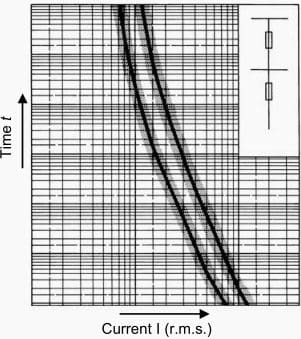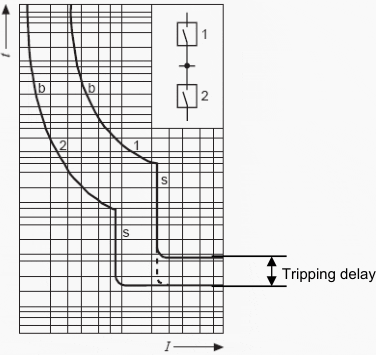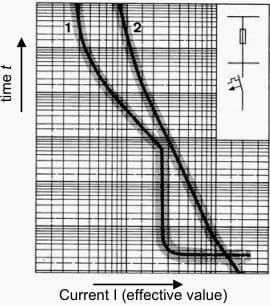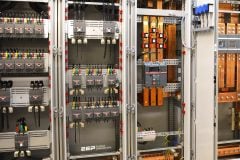Safety point
From the point of view of the operational safety and reliability of an entire low-voltage installation, it is usually desirable to specifically isolate the part of a system affected by a short-circuit in order to prevent spreading of the fault.

Selectivity is intended to ensure that the protective shutdown is as close as possible to the location of the fault so that unaffected installation components can continue to operate normally.
IEC 61439 standard – The new standard for low-voltage switchgear and controlgear ASSEMBLIES – Applies to enclosures for which the rated voltage is under 1000 V AC or 1500 V DC.
This is often also desired for safety reasons and in IEC 60439-1 (low-voltage switchgear assemblies) addressed for installations that require a high level of continuity in current supply.
In buildings and industrial plants, radial distribution networks are the norm. In radial distribution systems there are several protective devices in series, usually with decreasing rated currents from the supply end to the load end.
While the operational currents decrease from the supply end to the load end, in the event of a short-circuit the same fault current will flow through all the protective devices connected in series.
By a cascading of the trip characteristics it must be ensured that only the respective protective device that is closest to the location of the fault is activated and hence the fault is selectively limited to the smallest possible part of the installation. We saw in one of the previous technical article Simplify Downstream Installation with Cascading – that cascading actually makes protection system cheaper by simplifying the downstream installation (e.g. circuit breakers).
Special attention should be paid to the area of high overcurrents, where the effects of current limitation and breaking times are significant. Thus an upstream fuse does not operate if the entire I2t of the downstream protective device (fuse, circuit breaker) is smaller than the melting I2t the fuse. An upstream circuit breaker on the other hand does not operate if the maximum cut-off current ID of the downstream protective device is smaller than the activation value of its magnetic release.
In individual cases, reference to manufacture documents and frequently the technical support of the manufacturer is required for the correct selection of devices. The basic facts are presented below.
Selectivity between fuses connected in series
Fuses connected in series act selectively if their time current-characteristic curves have sufficient mutual spacing and their tolerance bands do not touch (Figure 1).

At high short-circuit currents the melting I2t value of the upstream fuse must be larger than the breaking I2t value (melting and clearing time) of the smaller downstream fuse. This is usually the case if their rated currents differ by a factor of 1.6 or more.
Selectivity of circuit breakers connected in series
Current selectivity
In distribution networks, the rated currents of the switches decrease constantly from the transformer to the load. As the short-circuit releases normally operate at a multiple of the rated current, their release levels decrease in the same way with distance from the supply.
As the prospective short-circuit currents also become smaller with increasing distance from the supply point due to line damping, a so-called natural selectivity can be created via the current magnitude.
This means that the maximum short-circuit current with a short-circuit on the load-side of the switch 2 (Figure 2) is below the trip value of the magnetic release of switch 1.
The short-circuit currents must be known at the installation sites of the switches. Selectivity is usually not assured with short-circuit currents above the response value of the magnetic release of the upstream circuit breaker.

b = Overload release
s = Short-circuit release
When assessing the current selectivity the tolerance of the short-circuit trigger (+/-20 % in accordance with IEC 60947-2) should be taken into account.
Time selectivity
If current selectivity between circuit breakers is not possible, selectivity must be achieved by cascading of the trip times, i.e. the upstream circuit breaker operates with a short delay to give the downstream circuit breaker time to clear the short-circuit.
If the short-circuit occurs between the two switches, then it will continue during the short trip delay time of the switch 1 and after lapse of this time it will be switched off by the latter (Figure 3).

b = Overload release
s = Short-circuit release (switch 1 with short-time delay; utilization category B)
The cascading of trip times requires that Switch 1 is capable of carrying the short-circuit current during the trip delay time. This is the case when using circuit breakers of utilization category B.
The critical variable is the rated short-time current Icw that determines the magnitude of the permissible short-time current during a defined period. It is usually stated as the 1s – current and can be converted for other times with I2t = const.
Selectivity between fuse and downstream circuit breaker

1 = Circuit breaker
2 = Fuse
In the overload range selectivity is given, if the trip characteristic of the overload release lies under the characteristic curve of the fuse (considering the tolerance band). In the short-circuit range selectivity is given to the extent that the total breaking time (including clearing time) of the circuit breaker is below the melting characteristic of the fuse.
Selectivity between a circuit breaker and downstream fuse

1 = Circuit breaker
2 = Fuse
Selectivity in the tripping range of the short-circuit release of the circuit breaker is given when the cut-off current of the fuse is smaller than its trip value.
Selectivity and undervoltage
In a short-circuit the supply voltage breaks down at the short-circuit location. The size of the residual voltage depends on the impedance of the fault. If an electric arc is produced, the voltage is appr. 30 V to 70 V.
All connected electrical consumers are affected by the voltage drop and the closer they are to the fault location the greater is this effect. Devices such as contactors or undervoltage releases of circuit breakers may trip depending on the amount and duration of the voltage drop.
In order to guarantee operational continuity, suitable off-delays or remaking equipment should be provided. When short-circuits are broken by current limiting circuit breakers, voltage break-downs are so short that no disruptions should be expected.
Resource: Allen Bradley – Low Voltage Switchgear and Controlgear











!!! Great article !!!
I enjoy reading the notes, article and resumes you write. Thank you very much for sharing them.
I’m an Electrical Engineer in position of Electrical Team Manager, I’ve read and enjoyed learning from you site, thank you for sharing and I would like to offer my service to and I want to contribute to the community,
Please reach me at the email above
Regards,